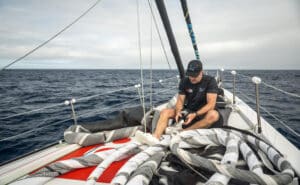
06 Jun A Day of Mayhem during New York Vendé
A Day of Mayhem during New York Vendée
Tuesday, June 5th, was a day filled with challenges for Canada Ocean Racing / Be Water Positive skipper Scott Shawyer. On Day 6 of the New York to Vendée France solo transatlantic yacht race, Scott faced multiple unpredictable setbacks.
The day began with an autopilot failure while Scott was below deck, leading to a wild crash gybe. For those unfamiliar, a ‘crash gybe’ is one of the most feared unintentional manoeuvres in sailing that often results in a sailboat being pinned on its side with the sails locked to windward, pushing the boat to a 90-degree angle or more, with the mast horizontal and the deck vertical. This not only disorients the sailor but also puts extreme stress on the mast, sails and general equipment.
If you have not seen the footage Scott captured during this incident, it is available on Canada Ocean Racing’s social media channels. The degree to which the boat is heeling over is initially hard to comprehend until you see Scott in the picture. The content is impressive, to say the least.
Despite the scare, Scott and the boat were relatively unscathed. After about an hour and a half of sorting out the mess, Scott was back on track.
However, a few hours later, a mechanical device at the base of one of Scott’s largest sails exploded into three pieces. This device is essential for rolling up the sail, making it manageable for a solo sailor to hoist and retrieve. It also attaches the sail to the front of the boat. The failure sent the sail skyward, with 300m2 of high-tech fabric flapping wildly from the mast. To create some perspective, this sail’s surface area is larger than a singles tennis court, which is 195.65m2.
Using the lines attached for shape control and by carefully lowering the halyard (the line used to hoist the sail), Scott managed to wrestle the lower section onto the foredeck and into an open hatch. Unfortunately, a wind increase caused Scott to lose control of the halyard, and the main body of the sail ended up in the water. Despite his best efforts to pull the sail back onboard, the loads were too extreme. Scott turned the boat into the wind to stop his forward progress, cut the halyard with a knife, and gradually retrieved the full sail, which he then safely stowed in the yacht’s bilge.
This ordeal was both dangerous and exhausting. To say that Scott was physically broken at the end of this challenge is an understatement. Additionally, the earlier autopilot failure had significantly restricted his ability to sleep or even rest, pushing Scott to his physical and mental limits.
After retrieving the sail, Scott immediately deployed a substitute sail to minimise his losses against the fleet and his immediate competitors. His next goal was to recover from the ordeal and while setting up to charge the boat batteries using the main engine alternator, the engine gear linkage engaged, causing the propeller shaft to rotate momentarily. Drive shafts on all boats in the fleet are locked and sealed with a tie that has an identification number. Although breaking these ties is not uncommon, it carries an automatic penalty. The penalty is cleared by not progressing beyond two waypoints established by the race organisation, remaining stationary on the course for a period of 70 minutes. As Scott put it, this was ‘a bit of insult to injury.’
Despite what was one of Scott’s most challenging days at sea, he only lost one fleet position due to the setbacks and his time in the penalty box. Scott used his penalty time to regroup, sort out the mess of broken pieces, and stow away meters of sailcloth and control lines strewn above and below deck. He found a better mode where his autopilot seemed more reliable, which allowed him to finally get some much-needed rest and begin his recovery.
Days like this are not unheard of in the IMOCA class. While the individual issues Scott faced have been experienced by most solo offshore sailors, the combination of cascading setbacks in such a short period of time is rare. Scott’s elite-level fitness and hard training in preparation for worst-case scenarios enabled him to manage these complications, quickly restore order and minimise his race performance losses.
The amazing footage of the crash gybe captured by the boat’s onboard media system has been widely circulated throughout the sailing and mainstream media, prompting a spike in supportive comments across various media channels and threads, including encouragement from some of Scott’s competitors in the fleet.
Today (Day 8 of the race) Scott continues to recover, aided by relatively stable wind conditions that permit the opportunity to sleep more frequently in short periods. Scott is still working hard,he has regained his 3rd place daggerboard/non-foiler fleet ranking and is progressing well through the overall fleet. He is now half way through this race and is expected to arrive in Les Sables d’Olonne, France in around 7 days time.


